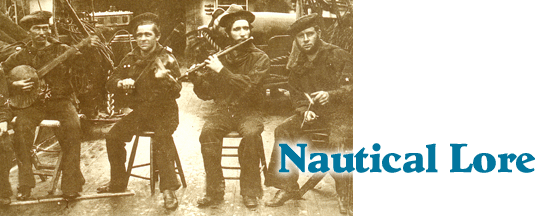Nautical Slang from the Nineteenth Century
By Chuck Veit
Reprinted
from On
Deck!
The
webzine of the Navy & Marine Living History Association
ttp://www.navyandmarine.org/ondeck/index.htm
Cape Horn fever - An illness feigned by a seaman seeking relief from duty.
Damage his pepper box - To attempt to assassinate the master-at-arms by dropping a round shot on his head from aloft or through an open hatchway
(A) Damn-my-eyes-tar - An inexperienced seaman who tried to cover his ignorance with blustering or boisterous behavior
Dance at the gratings - To be flogged formally with a cat
Double the grog tub - To get an extra ration of liquor by rejoining the line filing past the grog tub while liquor was being issued to the crew.
French leave - A sailor who absented himself temporarily with the intention of returning to his ship was said to have taken "French leave"
Horse marine - An insulting reference to a marine by the seamen. A great insult when applied to a sailor, implying he was unhandy or lubberly.
Kiss the wooden lady - To be forced to stand facing the bole of a wooden mast with arms encircling it and wrists lashed together as a minor punishment. Shipmates were encourage to kick the offender in the buttocks while passing by.
Purser rigged and parish damned - Said of a man who entered the navy to escape problems ashore; also of a man who entered the navy in a destitute condition
Rosewater sailor -An incompetent, foppish or unseamanlike officer
Ship a quarterdeck face again - After the relaxation of normal shipboard discipline during skylarking or a theatrical performance, officers customarily signified that all rules and regulations were back in force by resuming their customary formal demeanor towards the crew. This was called "shipping a quarterdeck face again."
Skin or Snake - A tube made out of livestock intestines worn wrapped around the body, esp. the ankles, used to smuggle liquor onto the ship.
Suck the monkey - To draw liquor out of a cask with a straw. Sailors ashore would partially empty the contents of casks of paint and refill them with alcohol. Once loaded onboard, the contents were allowed time to settle and separate -- pigment sinking to the bottom and alcohol to the top; presumably any remaining turpentine would end up in the middle. Piercing the top of the keg with a straw allowed the men to draw off the alcohol. It is unknown how many men died as a result of drinking turpentine! The phrase comes from the original practice of filling empty coconuts with alcohol, the three dark marks on the coconut resembling the face of a monkey.
White mouse - A lower deck informer or spy for the master-at-arms
Gun decking - Under certain circumstances drunkenness was not a naval crime. Shore liberty was granted very infrequently and it was expected that many of the men would return to the ship drunk, with clothes torn, and, bearing the marks of fights and riots. The officers of the deck merely recorded the return of each man in the logbook. A man returning in reasonable condition was logged as "CS," meaning clean and sober. A drunk was logged as "DD," which stood for drunk and dirty. A drunken libertyman had one prerogative that had grown up with the practice of granting shore leave. He was expected to conduct himself as best he could in the presence of the gangway watch; but upon reaching the gun deck, he was allowed to curse the officers, the ship, the navy, or any other institution in the vilest language he was capable of uttering with impunity. This practice was called "gundecking" and constituted one of the few ways which the men of the Old Navy had for releasing pent-up emotions.

 Red Cross
Red Cross
